EPoX 8HDA3+ (K8T800) Layout
Reference motherboards from the chipset manufacturers are usually the way to go when first evaluating a new design. In this case, though, two retail manufacturers have stepped on up to the plate and forwarded retail examples of both chipsets based on the Athlon 64 754-pin processor. Those being the EPoX 8HDA3+ and Shuttle AN50R for the VIA K8T800 and nForce3 150 respectively. Let's take a look.
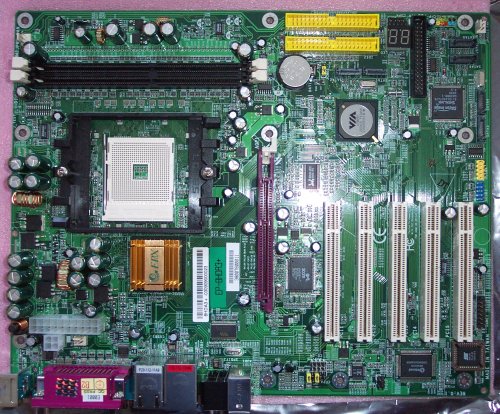
Get used to seeing this kind of socket formation and orientation, you'll be seeing a whole raft of motherboards based on the relatively inexpensive Clawhammer CPU. The Athlon 64 3200+ is priced at around £350, so it's relatively cheap when compared to the £675 Athlon 64 FX-51. EPoX's trademark green PCB colour is present here. On first glance, the layout looks clean and uncluttered. It's usual for EPoX to add a + to the end of a motherboard's name. This usually signifies that it's the premium board. Remember the recent 8RDA+, 8RDA3+, and 4PDA2+ boards ?.
The layout is a little different to most present K7-series of boards'. The 20-pin and 4-pin power connectors have been brought down on the board. That's not too much of a problem, because the wires can be pushed around the CPU socket. AMD XP / Duron line of CPUs had a ZIFF socket and, depending upon motherboard, 4 extra mounting holes around the socket. It's all change now, as AMD looks towards Intel for inspiration. The Clawhammer sports a lovely, tough heatspreader to protect its large and powerful core, so AMD decided to incorporate an Intel-like retention bracket into the overall design. We expect every single manufacturer, be they VIA or NVIDIA chipset collaborators, to adhere to it.
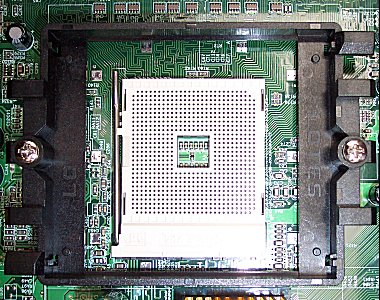

Coolers with bases of up to 80mm x 70mm can reside in the space inside the retention bracket. It's secured through to the back via 2 long screws which then attach to a holding plate on the back. The retention bracket, too, is made from tough plastic, so we have no qualms about attaching larger, heavier coolers. Coolers can either use the screw holes as a means of securing themselves on to the CPU or use a couple of lugs on each side, just to the left and right of the two holding screws. AMD's reference cooler used this method, and it also incorporated a plastic hold-down that lent further pressure on the CPU. The new Athlon 64s run cool as it is. We can look forward to powerful yet quiet computing. Also note how the K8T800 North Bridge is located in such close proximity to the CPU socket. It also has a small footprint as it doesn't need to undertake any DRAM controlling. EPoX sensibly epoxies a small heatsink on to it.

The DIMM shot is usually a gratuitous one, but this time EPoX appears to meld the two DIMM slots together. There's usually a small gap between a number of slots that's missing here, so users with chunky aluminium heatsinks on their RAM may find themselves in a little bother. It's also rare to see just two DIMM slots. The Clawhammer runs with an on-die single-channel 64-bit memory controller that feeds on to regular, unbuffered DRAM. We've yet to source 1GB modules at an attractive price point so you're kind of limited to 1GB of system memory in total (2 x 512MB modules). That's fine for the majority of users, but power users may want a little more RAM leeway. The Opteron / FX version will feature 4 DIMM slots.
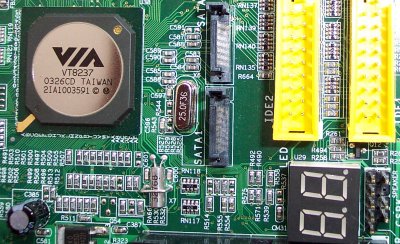
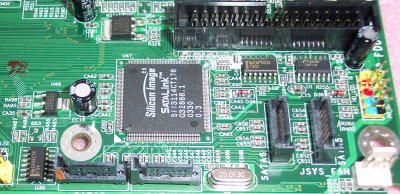
VIA's answer to Intel's ICH5/R is the VT8237 South Bridge. Perhaps VIA chose to not integrate the bridges into one package on the basis of having to omit certain features. As standard, the on-chip SATA controller runs two ports, shown to the right of the '8237. On-chip SATA precludes the use of the bandwidth limited PCI bus, and the controller can run SATA drives in independent (JBOD), RAID0 (striping with no redundancy) and RAID1 (mirroring) formats. The host interface has two transports, one of which run the controller and two ports shown above, and another that connects to a VIA Serial-ATA Lite interface, which in turn hooks up to an external physical layer that supports two extra ports. What that boils down to is the use of up to 4 ports, PHY permitting, and the possibility of adding RAID0+1 support. V-RAID software helps the user setup the desired combination of SATA. On another note, we're also pleased to see the presence of EPoX's excellent debug LED. The two yellow ATA133 ports have been pushed down the 8HDA3+.
The advantages of on-chip SATA are obvious. There's no PCI bus hogging, leaving it free for other bandwidth-taxing resources. It's a little bemusing why EPoX then decides to incorporate a 4-port PCI-based SATA controller from Silicon Image, as shown on the right. Wouldn't it have been better to extend the usefulness of the South Bridge by adding another 2 SATA ports to VIA's SATA-Lite interface ?. Of course, we would have lost two ports in total, but the on-chip characteristics would have made up for that, surely ?. EPoX's colour-coded jumper pins are a nice touch. A better CMOS jumper would have been preferable; it's a little difficult, in dexterity terms, to remove the jumper and clear CMOS. An ABIT-style oversized jumper would have been satisfactory.
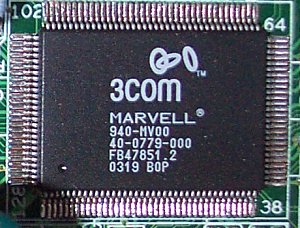
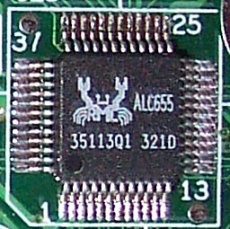
The K8T800 natively supports 6 33MHz / 32-bit PCI slots. EPoX have done away with one and placed a 3COM LOM (LAN On Motherboard) single-chip Gigabit Ethernet controller in the space that exists between the 8x AGP slot and first PCI slot. It's still run off the PCI bus as is the 4-port SATA controller. That's a lot of traffic heading up a 533MB/s link to the Northbridge. Further, add in probable USB2.0 usage and watch the link suffer. Wouldn't it be nice to have a full-speed HyperTransport link between the bridges. Something along the lines of 3.2GB/s in each direction, a la AMD. The features count continues with the new ALC655 software-accelerated CODEC from Realtek. It's one of the new AC'97 v2.3 breed. It also contains impedance sensing capability, such that it knows and corrects the user if an audio plug is connected into the wrong jack. It also supports the obligatory S/PDIF digital transfers.

The layout of the EPoX 8HDA3+ is close to being perfect. All storage ports are located next to one another, there's easy access to the CPU socket from all sides, a decent amount of space between the AGP and first PCI slots, and three useable fan headers. Perhaps only FireWire support is conspicuous by its absence. The I/O panel shows dual RJ45 ports. VIA's own VT6103 PHY provides standard 10/100MB Ethernet support and the aforementioned 3COM 3C940 provides Gigabit Ethernet support. 6-channel speaker and optical and coaxial S/PDIF support is also present. 4 USB2.0, out of a possible 8 from the VT8237, are incorporated here. The others are available by brackets. A pretty decent, robust implementation of the K8T800.









